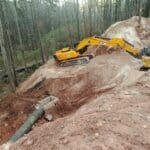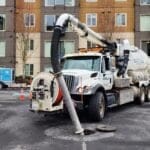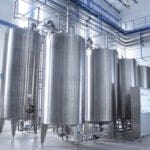Flushing PPE Is Flooding Businesses and Facilities: How to Prevent It
by Anna Espenhahn, Marketing Coordinator
It is not a new phenomenon in the wastewater industry. Non-flushable wipes, clothing, diapers, plastic, rocks, wood, and all non-dispersible debris are all flushed into sanitary systems on a regular basis.
However, Covid-19 has only exemplified the backups and blockages in underground sanitary infrastructure due to the increasing requirements of Personal Protection Equipment (PPE). These products, designed for one-time use, must be disposed of somehow, and many Americans are utilizing sanitary systems as their trash can for their PPE.
Designed to move wastewater from lower elevations to higher elevations so it can flow by gravity, lift stations or pump stations are common equipment utilized in sanitary systems. Due to the increase in improper disposal of face masks, gloves and sanitizing wipes, lift stations are facing failures at heightened rates compared to February 2020.
The overload of non-flushable products was evident early during the pandemic in the wastewater management community, leading the Environmental Protection Agency to release a statement in March 2020 discouraging the flushing of PPE to prevent backups that can cause raw sewage to back up and potentially infiltrate ecosystems.
Despite their efforts, issues continued throughout the country. During the height of public concern in May 2020, a new state-of-the-art lift station in El Paso, Texas, had to be cleared over 20 times in 24 hours due to the continuous disposal of PPE in the sanitary system.
Despite what packaging might say, wipes, cotton swaps, gloves, face masks, feminine hygiene products, and rags are not safe for sewer systems. These fibrous and elastic materials do not shred like toilet paper and can lead to clogs throughout the sewer system, including lift stations. This concern is not only applicable to municipal wastewater systems, but commercial industries such as health care facilities, retail, and food and beverage locations where PPE is required for entry could face catastrophic damages to their property if not adequately addressed. Preventative measures and advancements in technology can help property owners avoid backups, clogs, and flooding due to increased non-flushable items in their systems.
Educate and create awareness
At the highest level, the most effective preventative measure is to increase awareness and education regarding the proper disposal of PPE. Installing “do not flush” signs in restrooms can reduce the number of materials sent into the sanitation system. Any reduction will benefit lift station function, extending the system’s life cycle and reducing costly emergency services.
Ensure proper monthly inspections
Proper and routine inspections of lift stations are mandated in the state of Florida to address system functionality. Addressing deficiencies, frequent cleaning, visual inspection of the pump, including pulling the pump for visual analysis and electrical panel assessments, is the most effective way to clear clogs and decrease system downtime in lift stations. Adding these procedures to maintenance plans reduces the risk of clogging by addressing debris before it has a chance to accumulate.
If these materials are left to collect, system shut down is not immediate. Instead, systems will discharge less and pump harder, wearing down system components and increasing power usage, which can have costly consequences. Quarterly maintenance has been found to remove most long-term issues and eliminates an otherwise inevitable failure.
Use sewer grinder technology
Any facility that has reoccurring failure from pump damage can utilize grinder systems equipped with cutter technology to eliminate frequent emergency services. These grinders can shred fibrous materials and rocks, wood, hair, clothing, and plastic. These shredding devices offer facility managers tangible ROI in reducing costly repairs, emergency services, and property damages. These grinders offer technology specially designed to prevent clogging caused by fibrous wipe materials entangling within the system.
System monitoring through advancements
Continuous wastewater technology advancements allow property owners and facility managers to monitor and control pumps remotely, with alerts delivered in real-time via mobile device or email. Should systems functionality or output drop, property managers can be alerted in real-time before a significant clog or backup impacts the system. This preventative technology provides insight into your stations’ condition, including the ability to acknowledge alarms, track run times and send remote commands.
Clogs and backups due to non-dispersible debris are not a new pain point for municipalities and business owners when it comes to lift stations. However, PPE has only intensified the wear and tear on these systems. Ensuring proper inspections and routine preventative maintenance can decrease the need for frequent emergency response, mitigate property flooding and ensure all regulatory compliance measures.

 Kenosha, Wis. Highway KR Regenerative Stormwater ConveyanceThe Root-Pike Watershed Initiative Network Kenosha County, and others worked with AQUALIS to design and implement an innovative solution for stormwater control along Highway KR.
Kenosha, Wis. Highway KR Regenerative Stormwater ConveyanceThe Root-Pike Watershed Initiative Network Kenosha County, and others worked with AQUALIS to design and implement an innovative solution for stormwater control along Highway KR. Durham, N.C. Sinkhole Leads to Stormwater System RehabilitationThe tenant on this property noticed a depression that opened to the ground below and notified the property owners.
Durham, N.C. Sinkhole Leads to Stormwater System RehabilitationThe tenant on this property noticed a depression that opened to the ground below and notified the property owners.


